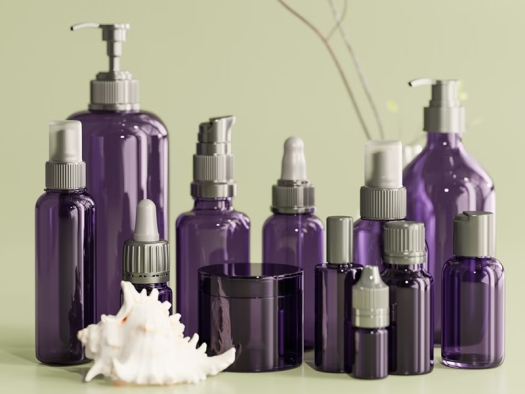A Look at Its Known and Emerging Side Effects
CosmeticsAndLotionsBottlesPurple.jpg

Image by pmv chamara / Unsplash License
Take a peek in your make-up bag, at the lotion in your bathroom cupboard, or the bottle of shampoo in your shower. Chances are, if you scroll through the list of ingredients, you’ll likely find the abbreviation “PEG” somewhere on that list.
PEG stands for polyethylene glycol and is a compound you can find lurking in more places than you might think. But just how safe is polyethylene glycol?
Today we’re going to explore not only some of the known and well-documented side effects of this compound – but we’re also going to look at some of the emerging and speculated side effects that may have a significant impact on its future use. Let’s dive in.
What Is Polyethylene Glycol?
Polyethylene glycol, or PEG for short, is a type of compound that’s derived from the by-products produced during the refinement of petroleum, natural gas, or coal.1 Polyethylene glycol is not a single chemical entity in and of itself. Rather it’s a category of compounds in which polyethylene and glycol have been bonded together.
Different forms of polyethylene glycol are usually delineated by placing a number after the abbreviation “PEG,” such as PEG-100, PEG-3350, and so on. This number represents the molecular weight of that specific compound.
Polyethylene glycol compounds are what’s known as hydrophilic – meaning they dissolve in water and tend to attract water.2 Because of its hydrophilic properties, polyethylene glycol has been utilized in many day-to-day products. Let’s explore some of the common uses for polyethylene glycol.
Polyethylene Glycol Uses
So what exactly is polyethylene glycol used for? Polyethylene glycol can be highly useful and is found in a wide range of products such as:
Osmotic Laxatives
One of the most widespread uses of PEG is in a class of medications known as osmotic laxatives, which are used to treat constipation. Because of PEG’s hydrophilic nature, it can draw fluid into the intestines and help hydrate stool. This allows for easier passage during bowel movements.
When used as a laxative, polyethylene glycol is typically taken in powder form mixed with water or juice and can be found under various names including:3
- ClearLax
- GaviLAX
- Gialax
- GlycoLax
- HealthyLax
- MiraLax
- PEG3350
- Sunmark ClearLax
But polyethylene glycol can also be found in more inconspicuous places.
Personal Care Products
Because of their affinity for dissolving in and attracting water, PEGs are regularly utilized in cosmetics as:4,5
- Emollients: Which help lubricate and soften skin or hair
- Emulsifiers: Which act as an agent to help water-based and oil-based ingredients combine properly
- Depth enhancers: Serving as a vehicle to help other ingredients penetrate into deeper levels of the skin or hair
Polyethylene glycol’s hydrophilic properties make it a highly practical compound in countless cosmetic and personal care products – from make-up to hair shampoo, and from anti-aging creams to baby wipes.
In topical application, I do not believe there is a concern about use of PEG. In fact I use my own clean beauty products, like the Dr. Jill Biopeptide Beauty cream that contains trace PEG daily.
Pharmaceuticals
PEG is also widely used in the production of pharmaceutical products, including:6
- As bases for ointments and creams
- As vehicles within drug capsules
- Binders in tablets and pills
- Suppositories
- Suspension aids in liquid prescriptions
- As cell-penetrating enhancers in vaccines
While found extensively in personal use products like prescriptions, cosmetics, and soaps, PEG can also be found in other places.
Industrial Uses
PEG can be found in a variety of industrial processes and products, such as:7
- Wood preservation
- Printing
- Chemical mixtures
- Textiles
- Leather processing
- Plastics
- Resins
- Paper
- Ceramics
- Glass
- Rubber
There’s no denying that polyethylene glycol is incredibly useful, but it has also been stirring up some controversy – having been linked to some undesirable effects with frequent ingestion or from contamination… read more below.
So, Is Polyethylene Glycol Toxic to Humans?
The answer to this question is – it’s complicated. You see, polyethylene glycol derivatives in and of themselves are not necessarily toxic or dangerous. The real concern surrounding polyethylene glycol is three-fold:
- Pollution: The process to produce polyethylene glycol requires a chemical reaction known as ethoxylation and the use of compounds known as ethylene oxide and 1,4-dioxane – two chemicals that have well-documented toxic effects on humans.
- Contamination: PEGs are widely utilized for their ability to enhance penetration and absorption. But this also means that prolonged use or high doses of PEG can significantly enhance your body’s absorption of other toxins and harmful compounds that are found alongside PEGs or within the environment.
- Lack of studies: Because polyethylene glycol has numerous derivatives and molecular weights, extensive studies have only been conducted on a handful of different PEG compounds. There is limited information on the real impact of PEGs as a whole and more PEG toxicity research is needed to truly understand this compound’s effects on the human body.
Despite a lack of studies or a clear picture of the exact impact PEG compounds have on our bodies, we do know that this compound can have some negative side effects.
Polyethylene Glycol Side Effects
Some of the confirmed and documented side effects of polyethylene glycol include:8,9
- Polyethylene glycol allergy: Although not commonly seen, there have been documented cases of an allergy to PEG. Some cases have even resulted in anaphylaxis – a severe and potentially life-threatening allergic reaction. Due to the risk of exposure to polyethylene glycol, the FDA has issued a warning to anyone with a known or suspected PEG allergy to communicate clearly with healthcare professionals as PEGs can be found lurking in medications, vaccines, contrast agents, and more.
- Digestive issues: If taken orally, polyethylene glycol can cause stomach upset such as diarrhea, flatulence, abdominal pain, nausea, vomiting, etc.
- Electrolyte imbalances: Because of its ability to disrupt the flow of water, PEG can also cause electrolyte imbalances. This may involve a decrease or increase in crucial electrolytes like calcium, sodium, potassium, and phosphate. It has also been linked to an increased risk of metabolic acidosis, which is a build-up of acid and toxins in the body.
While these side effects are well-documented, there are growing concerns about other possible polyethylene glycol toxicity symptoms.
Polyethylene Glycol Toxicity Symptoms
While it’s well-known among the medical community that PEG can trigger an allergy, cause digestive upset, or lead to electrolyte imbalances, there have been more and more reports of neurological symptoms associated with polyethylene glycol. Because of this reported increase in neuropsychiatric side effects, parents and pediatric practitioners are becoming increasingly wary of administering polyethylene glycol to adolescents.
A recent study found that a large percentage of parents, caregivers, and practitioners described an explosion of neurological side effects seemingly correlated to polyethylene glycol administration. Those side effects include:10
- Abnormal behavior
- Anger
- Anxiety
- Mood swings
- Seizures
- Sensory disturbances
Exactly how and why polyethylene glycol is triggering these neurological symptoms is still not entirely clear. And whether or not these side effects also extend to adults and geriatric patients will require further studies as well.
So, How Worried Should I Be About Polyethylene Glycol (PEG)?
Exactly how dangerous PEG truly is, is yet to be determined. But I’m a firm believer in being proactive and protective when it comes to your health. It’s not only impossible but also unnecessary to attempt to avoid PEG altogether. However, there are some simple yet powerful steps you can take to protect yourself against polyethylene glycol and other harmful toxins.
Here’s what I suggest:
- Prioritize clean supplements: You can find top quality professional supplements at Dr. Jill Health. I also recommend checking out my “products we love” page to browse through my tried-and-true non-toxic recommendations of some of my favorite things!
- Keep your gut happy and healthy: If you’re struggling with constipation, it’s likely a sign that your tummy could use some love. Instead of taking an over-the-counter laxative, I suggest addressing underlying issues and showing your gut some love.
- Enhance your detox pathways: Coming into contact with PEGs and other toxins is inevitable. But minimizing your toxic burden and enhancing your body’s natural detoxification capabilities goes a long way in preventing a build-up of toxins. Some of my favorite ways to boost detoxification include PEMF therapy, infrared saunas, and coffee enemas.
While there’s certainly no need to be alarmed when it comes to exposure to polyethylene glycol, being mindful and proactive can go a long way in protecting yourself and your loved ones from its potentially toxic effects.
When It Comes to Your Health, You’re in the Driver’s Seat
The truth is, we live in an increasingly toxic world. But when it comes to protecting and optimizing your health, you are in the driver’s seat. The choices you make on a day-to-day basis are the foundation of your well-being.
That’s why I’m dedicated to bringing you easy-to-understand and easy-to-implement tips – to take the confusion out of healthy living. So if you enjoyed this article and are looking for even more ways to take control of your and your family’s health, I encourage you to head over and browse through my blog. It’s chock-full of hundreds of articles to help you make your health a priority – without the overwhelm.
References
- #ChemicalCallout: Polyethylene Glycol Compounds (PEGs) (madesafe.org)
- Polyethylene Glycol – StatPearls – NCBI Bookshelf (nih.gov)
- Polyethylene glycol 3350 Uses, Side Effects & Warnings – Drugs.com
- Polyethylene Glycol – StatPearls – NCBI Bookshelf (nih.gov)
- The Dirty Dozen: PEG Compounds and their contaminants – David Suzuki Foundation
- Safety Evaluation of Polyethylene Glycol (PEG) Compounds for Cosmetic Use (nih.gov)
- Safety Evaluation of Polyethylene Glycol (PEG) Compounds for Cosmetic Use (nih.gov)
- Polyethylene Glycol-Induced Systemic Allergic Reactions (Anaphylaxis) – PubMed (nih.gov)
- Common and Rare Side Effects for polyethylene glycol 3350 oral (webmd.com)
- Probable neuropsychiatric toxicity of polyethylene glycol: roles of media, internet and the caregivers – Hussain – 2019 – GastroHep – Wiley Online Library
Is Polyethylene Glycol (PEG) Toxic? was originally published on Dr. Jill's blog on March 3, 2022; used with permission.


